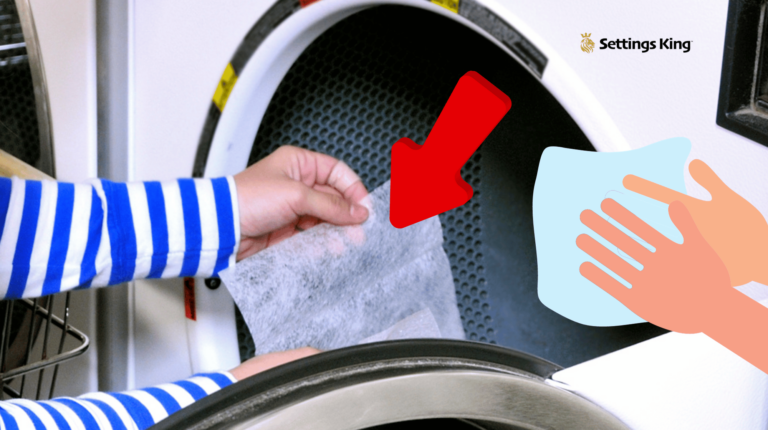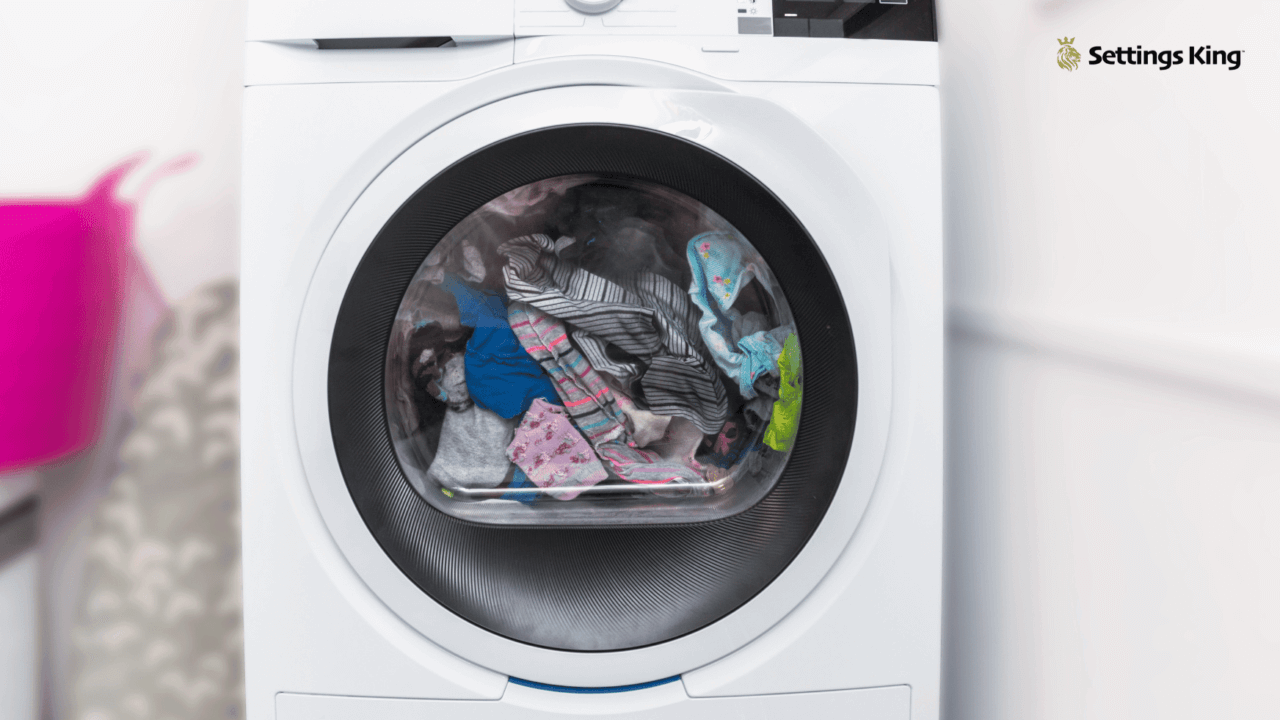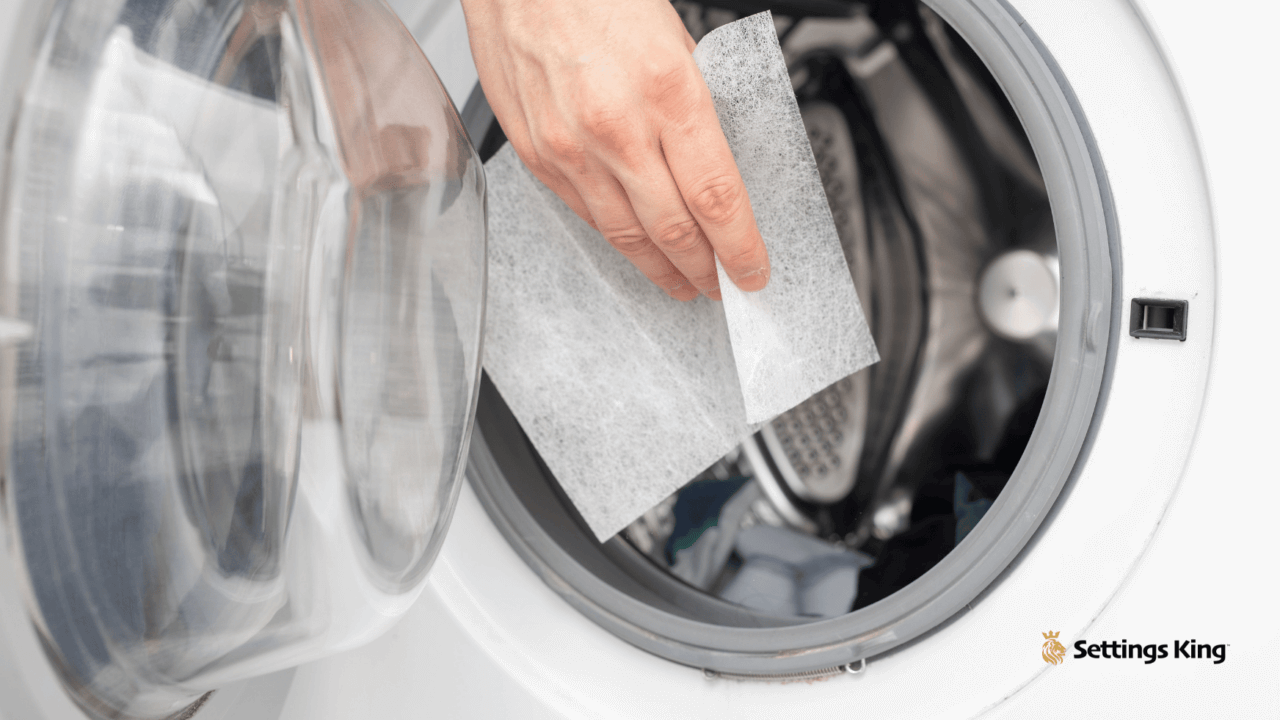

Dryer sheets are primarily used to reduce static cling, add fragrance, reduce wrinkles, and soften clothes during drying.
Dryer sheets have a simple yet effective composition: woven sheets typically coated with stearic acid or other similar fatty acids. When exposed to the dryer’s heat, these fatty acids melt and lightly coat the clothes. This action not only helps in reducing static but also makes the garments feel softer. In addition, many dryer sheets have added fragrances, ensuring your laundry smells fresh once the cycle completes.

Note: Consider using two dryer sheets for larger loads to maximize benefits. Always check garment care labels for any specific drying instructions.
Settings King Top Picks! See: Best Anti Static Dryer Sheets
For optimal results, typically, one dryer sheet is sufficient for a medium-sized load. However, two sheets might be needed for larger or heavily static-prone loads. It’s best to follow the manufacturer’s recommendations on the product packaging and adjust based on personal preferences and laundry size.
Dryer sheets are not strictly necessary but offer benefits like reducing static, imparting fragrance, and softening clothes. However, alternative methods and products, such as wool dryer balls or vinegar, can achieve similar results without using sheets. The choice depends on personal preferences and desired laundry outcomes.
Note: Always check garment care labels before using dryer sheets or any other additives, to maintain the fabric’s integrity and functionality.

Dryer sheets can have downsides. Some contain chemicals that might irritate sensitive skin or respiratory systems. They can also leave residue on clothes and dryer sensors and contribute to environmental waste. However, there are eco-friendly and hypoallergenic options available. Always check the product’s ingredients and choose what suits your needs.
Some dryer sheets contain chemicals that can be concerning to those with sensitivities, potentially causing skin or respiratory irritation. However, not all dryer sheets are toxic, and many brands offer eco-friendly and hypoallergenic options. Reading product ingredients and choosing sheets that align with your health and environmental preferences is essential.
Note: While dryer sheets have various alternative uses, always test on an inconspicuous spot before full application, especially on sensitive surfaces or fabrics.
While beneficial for many laundry purposes, dryer sheets can occasionally leave an oily residue. This residue can accumulate on your lint filter screen, obstructing airflow and possibly posing a safety risk. To ensure optimal dryer performance and safety:
Cleaning Tip: Always empty your lint filter after every cycle. Moreover, dedicate time once a month for a thorough lint filter wash to eliminate any persistent residue. Familiarize yourself with techniques on deep cleaning not only the lint filter but also the entirety of your dryer, inside and out. This proactive approach guarantees a safer, more efficient drying experience.
Dryer sheets were invented to tackle two main laundry challenges: static cling and wrinkled clothing. Before the advent of dryer sheets, static was a common problem when drying synthetic materials in an automatic dryer. This static would cause clothes to stick together and sometimes even result in a small electric shock when separating them.
In the early 1970s, Conrad J. Gaiser introduced the concept of the dryer sheet. Drawing inspiration from his experience of soaking a rag in a fabric softener and then adding it to the dryer, Gaiser came up with the idea of infusing paper sheets with fabric softener. The goal was to release the softener during the drying cycle, reducing static and giving clothes a fresh scent.
These dryer sheets grew popular because they made clothes feel softer, reduced static, added a pleasant fragrance, and made ironing easier due to fewer wrinkles. Over the years, the formula has been refined, and dryer sheets have become a staple in many households worldwide.
From their inception in the 1970s, dryer sheets primarily used fabric softening agents to combat static and impart a pleasant fragrance. Over the years, as environmental and health concerns gained traction, many brands transitioned towards greener and hypoallergenic components. Today, you’ll find a blend of traditional and eco-friendly dryer sheets in the market, catering to diverse consumer needs.
While dryer sheets are popular in the U.S., their usage varies globally. In many European and Asian countries, outdoor line drying remains prevalent, making dryer sheets less common. However, as urban spaces shrink and automatic dryers become more widespread, the adoption of dryer sheets is gradually increasing worldwide. Cultural preferences also play a role in fragrance choices and emphasizing eco-friendly products.
The single-use nature of traditional dryer sheets poses environmental concerns, particularly regarding waste and degradation. Recognizing this, several brands now offer biodegradable or reusable options. Additionally, DIY enthusiasts advocate for homemade recipes using natural ingredients, like vinegar and essential oils, as sustainable alternatives. These eco-friendly solutions reduce waste and often come without the added chemicals in commercial sheets.
Dryer sheets, while convenient, sometimes contain chemicals that can be of concern to those with sensitive skin or respiratory issues. Some users report skin reactions, while others express concerns over potential respiratory irritants. Always store dryer sheets away from children and pets, and consider hypoallergenic or natural options if you have sensitivities.
While dryer sheets add a nominal expense to each laundry cycle, their cumulative cost can increase over time. Savvy consumers often cut sheets in half for smaller loads or reuse them for other household tasks, like dusting. Comparatively, alternatives like wool dryer balls offer a one-time expense and can be used for hundreds of loads, presenting potential long-term savings.
Both dryer sheets and liquid fabric softeners aim to reduce static and soften fabrics. However, they differ in application and composition. Dryer sheets work in the dryer, releasing their softening agents from the heat, while liquid softeners are added during the washing cycle. Some users prefer the convenience and added fragrance of sheets, whereas others lean towards the consistent softening power of liquids. Evaluate your laundry priorities to determine the best choice for you.
The dryer sheet industry boasts a myriad of trusted brands, each carving out its unique niche:
As you navigate the market, remember that prices often reflect a brand’s reputation and ingredient quality. Tailor your choice based on your preferences and the specific benefits you value.
Dryer sheets are more than just laundry aids; they’re a part of many household tales. Some users recount using them as makeshift mosquito repellents, while others swear by their efficacy in freshening up old books or musty closets. Personal preferences also vary, with some loving the lingering fragrances and others opting for unscented versions to maintain a neutral aroma. Delving into these stories provides a holistic view of the product’s versatility and impact.
The future looks bright and innovative for dryer sheets. With advancements in technology, smart dryers are emerging that can adjust settings based on the fabric or load, potentially minimizing or even eliminating the need for dryer sheets. Furthermore, research into more sustainable and health-conscious ingredients is ongoing, paving the way for next-gen sheets that are kinder to both the environment and the consumer.
Understanding the role and benefits of dryer sheets can enhance your laundry routine. While they offer many advantages, being informed about potential drawbacks helps make an educated choice. Whether you stick to traditional dryer sheets or alternatives, the goal is always fresh, soft, and static-free clothes.